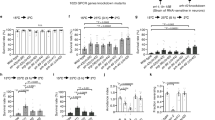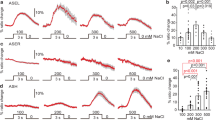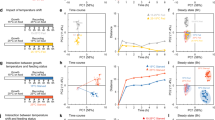Abstract
Animals cope with environmental changes by altering behavioral strategy. Environmental information is generally received by sensory neurons in the neural circuit that generates behavior. However, although environmental temperature inevitably influences an animal's entire body, the mechanism of systemic temperature perception remains largely unknown. We show here that systemic temperature signaling induces a change in a memory-based behavior in C. elegans. During behavioral conditioning, non-neuronal cells as well as neuronal cells respond to cultivation temperature through a heat-shock transcription factor that drives newly identified gene expression dynamics. This systemic temperature signaling regulates thermosensory neurons non-cell-autonomously through the estrogen signaling pathway, producing thermotactic behavior. We provide a link between systemic environmental recognition and behavioral plasticity in the nervous system.
This is a preview of subscription content, access via your institution
Access options
Subscribe to this journal
Receive 12 print issues and online access
$209.00 per year
only $17.42 per issue
Buy this article
- Purchase on Springer Link
- Instant access to full article PDF
Prices may be subject to local taxes which are calculated during checkout








Similar content being viewed by others
Accession codes
References
Conti, B. et al. Transgenic mice with a reduced core body temperature have an increased life span. Science 314, 825–828 (2006).
Bear, M.F., Connors, B.W. & Paradiso, M.A.A. Neuroscience: Exploring the Brain (Lippincott Williams & Wilkins, Maryland, USA, 2001).
Hedgecock, E.M. & Russell, R.L. Normal and mutant thermotaxis in the nematode Caenorhabditis elegans. Proc. Natl. Acad. Sci. USA 72, 4061–4065 (1975).
Mori, I. & Ohshima, Y. Neural regulation of thermotaxis in Caenorhabditis elegans. Nature 376, 344–348 (1995).
Mohri, A. et al. Genetic control of temperature preference in the nematode Caenorhabditis elegans. Genetics 169, 1437–1450 (2005).
Ito, H., Inada, H. & Mori, I. Quantitative analysis of thermotaxis in the nematode Caenorhabditis elegans. J. Neurosci. Methods 154, 45–52 (2006).
Biron, D. et al. A diacylglycerol kinase modulates long-term thermotactic behavioral plasticity in C. elegans. Nat. Neurosci. 9, 1499–1505 (2006).
Mori, I., Sasakura, H. & Kuhara, A. Worm thermotaxis: a model system for analyzing thermosensation and neural plasticity. Curr. Opin. Neurobiol. 17, 712–719 (2007).
Kuhara, A. et al. Temperature sensing by an olfactory neuron in a circuit controlling behavior of C. elegans. Science 320, 803–807 (2008).
Hsu, A.L., Murphy, C.T. & Kenyon, C. Regulation of aging and age-related disease by DAF-16 and heat-shock factor. Science 300, 1142–1145 (2003).
Akerfelt, M., Morimoto, R.I. & Sistonen, L. Heat shock factors: Integrators of cell stress, development and lifespan. Nat. Rev. Mol. Cell Biol. 11, 545–555 (2010).
Zimarino, V. & Wu, C. Induction of sequence-specific binding of Drosophila heat shock activator protein without protein synthesis. Nature 327, 727–730 (1987).
Mosser, D.D., Kotzbauer, P.T., Sarge, K.D. & Morimoto, R.I. In vitro activation of heat shock transcription factor DNA-binding by calcium and biochemical conditions that affect protein conformation. Proc. Natl. Acad. Sci. USA 87, 3748–3752 (1990).
Goodson, M.L. & Sarge, K.D. Heat-inducible DNA binding of purified heat shock transcription factor 1. J. Biol. Chem. 270, 2447–2450 (1995).
Morimoto, R.I. Regulation of the heat shock transcriptional response: cross talk between a family of heat shock factors, molecular chaperones, and negative regulators. Genes Dev. 12, 3788–3796 (1998).
Prahlad, V., Cornelius, T. & Morimoto, R.I. Regulation of the cellular heat shock response in Caenorhabditis elegans by thermosensory neurons. Science 320, 811–814 (2008).
Clos, J., Rabindran, S., Wisniewski, J. & Wu, C. Induction temperature of human heat shock factor is reprogrammed in a Drosophila cell environment. Nature 364, 252–255 (1993).
Devaney, E. Thermoregulation in the life cycle of nematodes. Int. J. Parasitol. 36, 641–649 (2006).
Hajdu-Cronin, Y.M., Chen, W.J. & Sternberg, P.W. The L-type cyclin CYL-1 and the heat-shock-factor HSF-1 are required for heat-shock-induced protein expression in Caenorhabditis elegans. Genetics 168, 1937–1949 (2004).
Bargmann, C.I., Hartwieg, E. & Horvitz, H.R. Odorant-selective genes and neurons mediate olfaction in C. elegans. Cell 74, 515–527 (1993).
Okochi, Y., Kimura, K.D., Ohta, A. & Mori, I. Diverse regulation of sensory signaling by C. elegans nPKC-epsilon/eta TTX-4. EMBO J. 24, 2127–2137 (2005).
Morley, J.F. & Morimoto, R.I. Regulation of longevity in Caenorhabditis elegans by heat shock factor and molecular chaperones. Mol. Biol. Cell 15, 657–664 (2004).
Biron, D., Wasserman, S., Thomas, J.H., Samuel, A.D. & Sengupta, P. An olfactory neuron responds stochastically to temperature and modulates Caenorhabditis elegans thermotactic behavior. Proc. Natl. Acad. Sci. USA 105, 11002–11007 (2008).
Hobert, O. et al. Regulation of interneuron function in the C. elegans thermoregulatory pathway by the ttx-3 LIM homeobox gene. Neuron 19, 345–357 (1997).
Altun-Gultekin, Z. et al. A regulatory cascade of three homeobox genes, ceh-10, ttx-3 and ceh-23, controls cell fate specification of a defined interneuron class in C. elegans. Development 128, 1951–1969 (2001).
Zariwala, H.A., Miller, A.C., Faumont, S. & Lockery, S.R. Step response analysis of thermotaxis in Caenorhabditis elegans. J. Neurosci. 23, 4369–4377 (2003).
Lee, S.J. & Kenyon, C. Regulation of the longevity response to temperature by thermosensory neurons in Caenorhabditis elegans. Curr. Biol. 19, 715–722 (2009).
Kimura, K.D., Miyawaki, A., Matsumoto, K. & Mori, I. The C. elegans thermosensory neuron AFD responds to warming. Curr. Biol. 14, 1291–1295 (2004).
Liu, F. et al. Activation of estrogen receptor-beta regulates hippocampal synaptic plasticity and improves memory. Nat. Neurosci. 11, 334–343 (2008).
Woolley, C.S. Acute effects of estrogen on neuronal physiology. Annu. Rev. Pharmacol. Toxicol. 47, 657–680 (2007).
Wu, M.V. et al. Estrogen masculinizes neural pathways and sex-specific behaviors. Cell 139, 61–72 (2009).
Mimoto, A. et al. Identification of an estrogenic hormone receptor in Caenorhabditis elegans. Biochem. Biophys. Res. Commun. 364, 883–888 (2007).
Lumpkin, E.A. & Caterina, M.J. Mechanisms of sensory transduction in the skin. Nature 445, 858–865 (2007).
Hamada, F.N. et al. An internal thermal sensor controlling temperature preference in Drosophila. Nature 454, 217–220 (2008).
Xiang, Y. et al. Light-avoidance-mediating photoreceptors tile the Drosophila larval body wall. Nature 468, 921–926 (2010).
Chatzigeorgiou, M. et al. Specific roles for DEG/ENaC and TRP channels in touch and thermosensation in C. elegans nociceptors. Nat. Neurosci. 13, 861–868 (2010).
Mello, C.C., Kramer, J.M., Stinchcomb, D. & Ambros, V. Efficient gene transfer in C.elegans: extrachromosomal maintenance and integration of transforming sequences. EMBO J. 10, 3959–3970 (1991).
Von Stetina, S.E. et al. Cell-specific microarray profiling experiments reveal a comprehensive picture of gene expression in the C. elegans nervous system. Genome Biol. 8, R135 (2007).
Watson, J.D. et al. Complementary RNA amplification methods enhance microarray identification of transcripts expressed in the C. elegans nervous system. BMC Genomics 9, 84–97 (2008).
Irizarry, R.A. et al. Summaries of Affymetrix GeneChip probe level data. Nucleic Acids Res. 31, e15 (2003).
Murphy, C.T. et al. Genes that act downstream of DAF-16 to influence the lifespan of Caenorhabditis elegans. Nature 424, 277–283 (2003).
Acknowledgements
We thank N. Hisamoto (Nagoya University), T. Mizuno (Nagoya University) and K. Matsumoto (Nagoya University) for sharing strains; A. Fire (Stanford University School of Medicine) for pPD plasmids; Y. Iino (University of Tokyo) for the gcy-5 and gcy-7 promoters; Caenorhabditis Genetic Center, C. elegans Knockout Consortium and S. Mitani at the National Bioresource Project, Japan, for strains; K. Terauchi and T. Kondo for kindly sharing the microarray apparatus; T. Inada for kindly sharing the quantitative PCR apparatus; C. Bargmann, S. Takagi, N. Hisamoto, A. Kuhara, P. Jurado, H. Sasakura, N. Ohnishi, T. Kimata, M. Nonomura and members of the Mori laboratory for comments on this manuscript and discussion. I.M. is a Scholar of the Institute for Advanced Research in Nagoya University, Japan. This work was supported by the Core Research for Evolutional Science and Technology (CREST) Program of the Japan Science and Technology (JST) agency (to I.M.).
Author information
Authors and Affiliations
Contributions
T.S. designed the research, performed most experiments, analyzed data and wrote the manuscript; Y.N. performed the quantitative PCR experiments and conducted germline transformation to construct the C. elegans transgenic line; I.M. supervised the project, conducted initial identification of cells expressing the hsf-1 promoter::gfp reporter gene and wrote the manuscript.
Corresponding author
Ethics declarations
Competing interests
The authors declare no competing financial interests.
Supplementary information
Supplementary Text and Figures
Supplementary Figures 1–9, Supplementary Strains and Plasmids (PDF 14251 kb)
Rights and permissions
About this article
Cite this article
Sugi, T., Nishida, Y. & Mori, I. Regulation of behavioral plasticity by systemic temperature signaling in Caenorhabditis elegans. Nat Neurosci 14, 984–992 (2011). https://doi.org/10.1038/nn.2854
Received:
Accepted:
Published:
Issue Date:
DOI: https://doi.org/10.1038/nn.2854
This article is cited by
-
The extraordinary AFD thermosensor of C. elegans
Pflügers Archiv - European Journal of Physiology (2018)
-
The heat shock response and humoral immune response are mutually antagonistic in honey bees
Scientific Reports (2017)
-
Thermosensation and longevity
Journal of Comparative Physiology A (2015)
-
Light and pheromone-sensing neurons regulates cold habituation through insulin signalling in Caenorhabditis elegans
Nature Communications (2014)
-
Systematic temperature signaling regulates behavior plasticity
Protein & Cell (2011)



